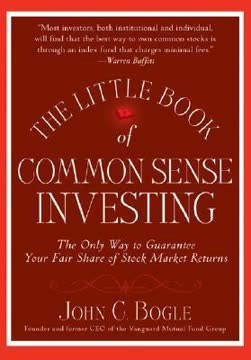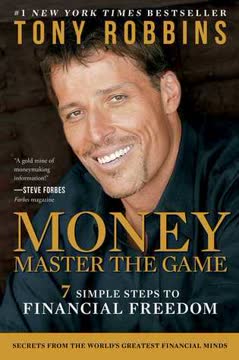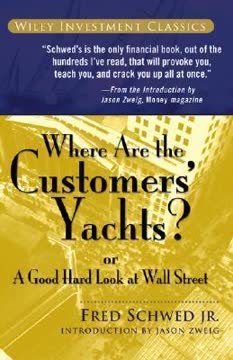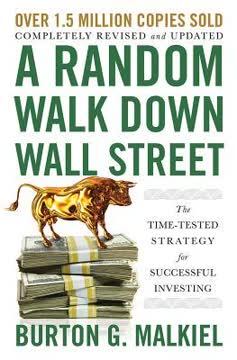重点摘要
1. 早期储蓄并持续储蓄以实现财务安全
“致富的快速方法很简单:将你的开支大幅减少到低于收入——哗啦!——你就富裕了,因为你的收入超过了支出。”
先支付自己。 财务安全的基础是持续储蓄。尽早开始,即使金额很小。通过设置定期向投资账户的自动转账来自动化你的储蓄。这一习惯确保你随着时间的推移稳步积累财富。
量入为出。 培养节俭和有意识消费的心态。区分需求和欲望,并优先考虑长期财务目标而非短期满足。可以考虑使用以下技巧:
- 制定详细的预算
- 仔细跟踪开支
- 寻找不牺牲生活质量的创意节省方法
- 随着收入增长避免生活方式膨胀
记住,这不是关于剥夺,而是关于做出与财务目标一致的有意选择。
2. 利用复利的力量
“慢慢但肯定致富的秘密是复利的奇迹。”
时间是你最大的盟友。 复利使你的钱随着时间的推移呈指数增长。你越早开始投资,你的钱就有越多的时间复利,可能导致显著的财富积累。
了解72法则。 这个简单的公式帮助你估算投资翻倍所需的时间:
- 用72除以你预期的年回报率
- 结果是你的投资翻倍所需的大致年数
例如:
- 在7%的年回报率下,你的投资大约在10年内翻倍(72 ÷ 7 = 10.3)
- 在10%的年回报率下,大约在7年内翻倍(72 ÷ 10 = 7.2)
这个法则说明了为什么尽早开始和获得稍高的回报率会对你的长期财富产生巨大影响。
3. 广泛分散你的投资组合
“在证券、资产类别、市场和时间上进行分散。”
分散风险。 分散投资是管理投资风险的关键策略。通过将投资分散在不同的资产类别、行业和地理区域,你可以减少任何单一领域表现不佳的影响。
关键的分散策略:
- 资产类别:混合股票、债券、房地产和可能的商品
- 地理区域:投资于国内和国际市场
- 公司规模:包括大盘股、中盘股和小盘股
- 行业:将投资分散在各个行业
- 时间:使用定期定额投资法定期投资
记住,分散投资不能保证利润或防止损失,但它可以帮助管理风险并可能在长期内提高回报。
4. 选择低成本指数基金以实现长期成功
“没有人比市场更了解。”
接受市场效率。 所有市场参与者的集体智慧非常难以持续击败。与其试图超越市场,不如通过低成本指数基金捕捉其整体回报。
指数基金的好处:
- 低费用:通常比主动管理基金收费低得多
- 广泛分散:自动分散风险于许多证券
- 税收效率:较少的交易导致较少的应税事件
- 简单性:易于理解和管理
研究一致表明,大多数主动管理基金在长期内表现不如其基准指数,尤其是在考虑费用之后。通过选择低成本指数基金,你可以在最小化成本和复杂性的同时捕捉市场回报。
5. 避免常见的投资错误和情绪化决策
“作为人类,我们喜欢被告知未来会发生什么。占卜师和占星家在历史上一直在做预测。”
控制你的情绪。 许多投资错误源于对市场波动的情绪反应或试图把握市场时机。认识到可能导致错误决策的常见心理偏见:
- 过度自信:相信自己能持续击败市场
- 羊群效应:跟随大众投资热门项目
- 近期偏见:过分重视近期事件
- 损失厌恶:对损失的恐惧超过对等值收益的重视
避免这些陷阱的策略:
- 制定长期投资计划并坚持执行
- 忽略短期市场噪音和预测
- 避免过于频繁地查看你的投资组合
- 使用自动投资以消除情绪影响
- 学习行为金融学以识别自己的偏见
记住,成功的投资往往是关于耐心和纪律,而不是试图超越市场。
6. 每年重新平衡你的投资组合
“重新平衡意味着定期(如每年一次)查看你的投资组合的资产配置,并将其恢复到让你感到舒适的平衡状态。”
保持目标配置。 随着时间的推移,你的投资组合的不同部分表现不同,导致资产配置偏离原计划。年度重新平衡有助于你保持期望的风险水平,并可能提高回报。
重新平衡过程:
- 审查你当前的资产配置
- 将其与目标配置进行比较
- 卖出超重资产,买入不足资产以重新调整
重新平衡的好处:
- 使你的投资组合与风险承受能力保持一致
- 迫使你低买高卖
- 帮助保持分散投资
- 提供系统的投资组合管理方法
考虑使用阈值重新平衡,当某一资产类别偏离目标配置一定百分比(如5%)时进行重新平衡,而不是按固定时间表。
7. 利用税收优惠的退休账户
“因为美国政府希望鼓励我们更多地储蓄,有各种退休计划允许纳税人从联邦税中扣除他们储蓄的每一美元。”
最大化税收优惠。 充分利用税收优惠的退休账户来增加你的储蓄和投资回报。这些账户提供税收减免、免税增长或退休时免税提取等好处。
考虑的主要退休账户:
- 401(k)或403(b):雇主赞助的计划,可能有匹配贡献
- 传统IRA:税收减免的贡献和递延增长
- Roth IRA:税后贡献,免税增长和提取
- SEP IRA或Solo 401(k):适合自雇人士的选择
优先贡献顺序:
- 向401(k)贡献足够以获得全额雇主匹配
- 最大化IRA贡献(根据你的情况选择传统或Roth)
- 最大化401(k)贡献
- 如果已最大化退休账户,考虑额外的应税投资
记住每年审查贡献限额,因为它们可能会随时间变化。
8. 随年龄调整你的投资策略
“个人投资者的适当配置取决于几个关键因素。主要因素是年龄。”
随着时间调整风险。 随着你经历不同的人生阶段,你的投资策略应随之演变,以匹配你不断变化的目标、时间跨度和风险承受能力。一般来说,年轻投资者可以承担更多风险,而接近退休的人应关注资本保值。
按年龄划分的一般资产配置指南:
- 20-30岁:90-100%股票
- 40-50岁:80-90%股票,10-20%债券
- 60岁:70-80%股票,20-30%债券
- 70岁:60-70%股票,30-40%债券
- 80岁及以上:50-60%股票,40-50%债券
这些只是指南;你的个人情况可能需要不同的配置。考虑因素包括:
- 你的风险承受能力
- 其他收入来源(如养老金)
- 整体财务状况
- 健康和预期寿命
- 遗产目标
定期审查和调整你的投资策略,以确保其与不断变化的需求和情况保持一致。
9. 在市场波动期间坚持不懈
“当你周围的人都失去理智时,只需站在那里什么也不做。保持眼睛和头脑专注于长期。”
保持视角。 市场波动是正常且不可避免的。短期波动,即使是严重的,也不会否定市场的长期上升趋势。通过在动荡时期保持投资,你可以为捕捉最终的复苏做好准备。
应对市场波动的策略:
- 重塑你的视角:将市场下跌视为以较低价格买入的机会
- 避免媒体炒作:减少对耸人听闻的金融新闻的关注
- 审查你的资产配置:确保其与风险承受能力和时间跨度一致
- 继续定期投资:使用定期定额投资法可能从较低价格中受益
- 专注于你的目标:记住你为什么投资以及你的长期目标
如果市场波动引起了显著的压力,这可能表明你的资产配置对你的风险承受能力来说过于激进。考虑将你的投资组合调整到更舒适的风险水平,但避免基于短期市场波动做出剧烈变化。
最后更新日期:
FAQ
What's "The Elements of Investing" about?
- Purpose: "The Elements of Investing" by Burton G. Malkiel and Charles D. Ellis is a guide to personal finance and investing, aimed at providing easy-to-understand lessons for every investor.
- Content: The book distills the authors' extensive experience into a sensible plan for saving and investing, focusing on simplicity and practicality.
- Structure: It covers topics such as saving, index funds, diversification, avoiding investment blunders, and keeping investment strategies simple.
- Audience: It is intended for both new and seasoned investors, offering timeless advice that can be applied throughout one's investing journey.
Why should I read "The Elements of Investing"?
- Simplicity: The book offers straightforward, jargon-free advice that is accessible to all levels of investors.
- Proven Strategies: It provides time-tested strategies that have helped millions achieve financial success.
- Comprehensive Guidance: From saving to investing in retirement, the book covers all essential aspects of personal finance.
- Expert Authors: Written by renowned investment experts, the book distills decades of experience into practical advice.
What are the key takeaways of "The Elements of Investing"?
- Start Saving Early: The book emphasizes the importance of saving early and regularly to take advantage of compound interest.
- Index Funds: It advocates for investing in low-cost index funds as a way to achieve market returns without the high fees of active management.
- Diversification: Diversifying across asset classes, markets, and time is crucial to reducing investment risk.
- Avoiding Mistakes: The book highlights common investment blunders and how to avoid them, such as overconfidence and market timing.
What is the Rule of 72 mentioned in "The Elements of Investing"?
- Definition: The Rule of 72 is a simple formula used to estimate the number of years required to double an investment at a fixed annual rate of return.
- Formula: Divide 72 by the annual rate of return to get the approximate number of years needed to double the investment.
- Example: At an 8% return, it takes approximately 9 years to double your money (72 divided by 8).
- Application: This rule helps investors understand the power of compounding and the importance of starting early.
How does "The Elements of Investing" suggest you diversify your investments?
- Across Asset Classes: Diversify by holding a mix of stocks, bonds, and real estate to spread risk.
- Across Markets: Include international investments to benefit from global economic growth and reduce reliance on any single market.
- Over Time: Use dollar-cost averaging to invest regularly over time, reducing the risk of market timing.
- Broad Index Funds: Invest in broad-based index funds to achieve diversification with minimal effort and cost.
What are the benefits of index funds according to "The Elements of Investing"?
- Low Costs: Index funds typically have lower management fees compared to actively managed funds, increasing net returns.
- Market Returns: They aim to replicate market performance, providing consistent returns over time.
- Tax Efficiency: With less frequent trading, index funds often generate fewer taxable events, benefiting investors in taxable accounts.
- Simplicity: They offer a straightforward way to invest in a diversified portfolio without the need for constant monitoring.
What mistakes should investors avoid according to "The Elements of Investing"?
- Overconfidence: Believing you can consistently beat the market can lead to risky and costly investment decisions.
- Market Timing: Attempting to predict market movements often results in buying high and selling low.
- High Costs: Paying high fees for active management can significantly reduce investment returns over time.
- Ignoring Diversification: Failing to diversify can expose your portfolio to unnecessary risk and volatility.
How does "The Elements of Investing" recommend you approach asset allocation?
- Age-Based Allocation: Adjust your asset mix based on your age, with more stocks when young and more bonds as you approach retirement.
- Risk Tolerance: Consider your comfort with market fluctuations when determining your stock-bond allocation.
- Rebalancing: Periodically adjust your portfolio to maintain your desired asset allocation, especially after significant market movements.
- Personal Circumstances: Tailor your allocation to your financial situation, goals, and investment horizon.
What is the KISS investing strategy in "The Elements of Investing"?
- Keep It Simple, Sweetheart: Focus on simple, straightforward investment strategies that are easy to understand and implement.
- Index Funds: Use low-cost index funds for broad market exposure and diversification.
- Regular Saving: Emphasize the importance of saving regularly and starting early to build wealth over time.
- Long-Term Focus: Ignore short-term market fluctuations and stay committed to your investment plan.
What are the best quotes from "The Elements of Investing" and what do they mean?
- "The secret of getting rich slowly but surely is the miracle of compound interest." This highlights the power of compounding and the importance of starting to save early.
- "Nobody knows more than the market." This emphasizes the efficiency of markets and the difficulty of consistently outperforming them.
- "Diversify, Diversify, Diversify." A reminder of the importance of spreading investments across different asset classes to reduce risk.
- "Minimize your investment costs." A fundamental principle that underscores the impact of fees on long-term investment returns.
How does "The Elements of Investing" address investing during volatile times?
- Stay the Course: The book advises against making impulsive decisions based on short-term market volatility.
- Rebalancing: Use market fluctuations as an opportunity to rebalance your portfolio and maintain your desired asset allocation.
- Dollar-Cost Averaging: Continue investing regularly to take advantage of lower prices during market downturns.
- Focus on Long-Term Goals: Keep your investment strategy aligned with your long-term financial objectives, regardless of market conditions.
What is the significance of the "Confession" section in "The Elements of Investing"?
- Honesty: The authors share their personal investment experiences, acknowledging that even experts can have biases and make mistakes.
- Real-Life Examples: They illustrate how personal preferences and emotions can influence investment decisions.
- Indexing Core Investments: Despite personal stock picks, the authors emphasize that their core retirement funds are safely indexed.
- Learning from Mistakes: The section serves as a reminder that disciplined investing and sticking to proven strategies are crucial for success.
评论
《投资要素》获得了大多数正面评价,因其简明、直接的基本投资原则建议而备受赞誉。读者们欣赏其对指数基金、多样化和长期策略的关注。许多人认为这本书非常适合初学者或需要复习的人。一些人批评其内容过于简单、重复性高且偏向美国市场。书中强调早期储蓄、避免债务和使用低成本指数基金。尽管有经验的投资者可能不会发现太多新信息,但许多人仍然推荐它作为投资入门的必读书籍。
Similar Books















